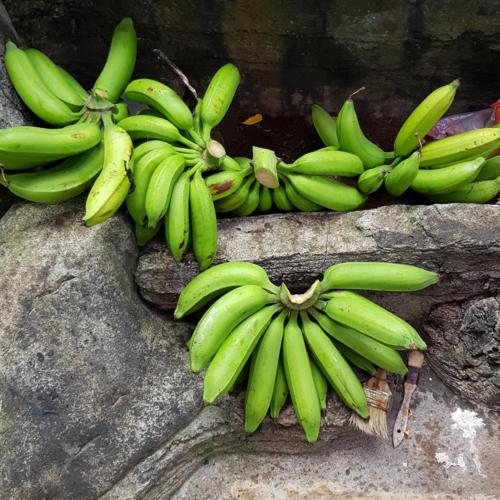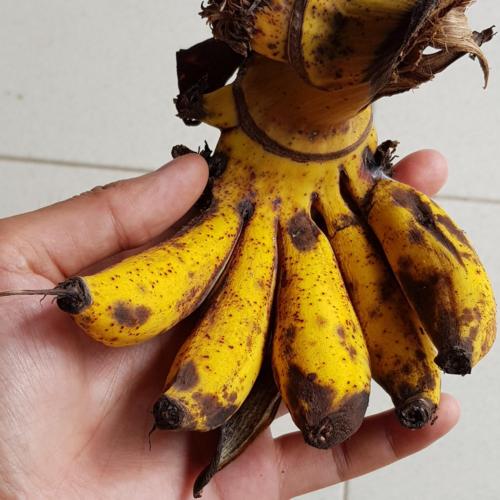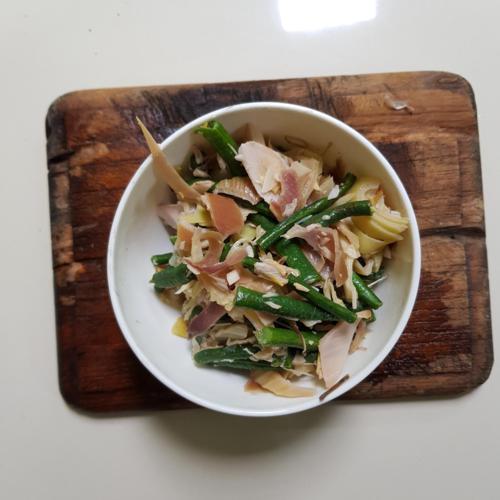January 10, 2021 by IG
Kitchen Garden: A Journey to the Heart of the Banana
Let me start by introducing Kitchen Garden, a series highlighting ingredients that can be grown at home and featuring recipes using those ingredients. Our first recipe comes from yuuki in tropical Indonesia. The featured ingredient is banana heart.
What I Learned About Bananas Thanks to Yuuki’s Infinite Patience
I have to admit, I never gave bananas too much thought. They’re yellow, soft and sweet. And of course, they’re all the same. Except, that’s not at all true. There are over 1000 varieties in the genus Musa grown in more than 150 countries. The one I’m familiar with, the yellow, soft, sweet one is Cavendish (a cultivar of Musa acuminata), the most commonly imported variety to the United States. But banana colors run the gamut from green to yellow to red to almost black. And while I think of bananas as soft and sweet and plantains as an entirely different plant, worldwide, there is no sharp distinction between “bananas” and the more potato textured “cooking bananas” referred to as plantains in the US. In fact, many more varieties exist that are eaten both raw and cooked. In Indonesia, they are all referred to as pisang.
Yuuki’s parents have six types of bananas growing in their garden in Indonesia: Pisang Batu (M. balbisiana), Pisang Morosebo (Dwarf Cavendish), Pisang Raja Sere (M. paradisiaca), Pisang Nangka (M. paradisiaca), Pisang Susu (M. acuminata non-Cavendish), and the cooking, plantain variety Pisang Tanduk.
Here’s how yuuki describes these bananas:
Pisang Morosebo looks like Cavendish but smaller. The texture and the taste are also like Cavendish. The difference is the size of the tree, which is half of the usual size.
Pisang Raja Sereh’s size is also smaller than Cavendish, it is softer than Cavendish and has a slightly different texture.
Pisang Nangka is starchy. Because of that, it is better eaten cooked. Texture is similar to plantain.
Pisang Susu is very small, the size is about three adult fingers clumped together. The taste is good, sweet and the size is just nice for snacking. The banana skin is thinner than Cavendish.
Pisang Batu is the banana that contains seeds so it’s hard to eat, although we eat the young ones by smashing them and mixing with other fruits and coconut sugar. This banana’s heart is edible and used for cooking because it has less sap. The trees are very big and the leaves are good for traditional food wrappers. It is used more for its leaves and the banana heart.
While referred to as a tree, the banana plant is actually an herbaceous perennial grown from a corm and related not to palms, as one might think, but to ginger. A banana heart is the inflorescence of a banana plant. The inflorescence contains many bracts between rows of flowers. The female flowers develop into fruit. These fruit grow in a large hanging cluster known as a bunch with tiers called “hands”. Each “hand” can have up to 20 “fingers” (Ick! Let’s just call them bananas.) and as many as 20 tiers can develop. However, because of depleting energy needed to produce many tears, eventually the new bananas become smaller or stop developing entirely. At this point, the grower may chose to cut off the banana heart, allowing the plant to put energy into growing and ripening existing hands. And the banana heart can be cooked.
Sautéed Banana Heart
Ingredients
- 1 banana heart, thinly sliced
- 7 small shallots, sliced
- 5 garlic cloves, sliced
- 3-4 thin slices of galanga
- 3 bay leaves
- 5-7 long beans cut into 3 cm pieces (optional)
- Red chili peppers, to taste
- Salt
- Sugar (optional)
Directions
- Steam the banana heart slices for 10 minutes.
- Saute garlic in olive or coconut oil until aromatic, add shallot and saute several minutes until lightly browned. Add galanga, chili peppers and bay leaves, cook until bay leaves change color from dark green to dark brown.
- If using long beans, add them now with 1 cup of water. Cook for about 5 minutes until most of the water has cooked off and beans are cooked. Add more water if necessary.
- Add steamed banana heart slices to the pan and cook for several more minutes. Add a pinch of sugar (if using) and salt to taste, stir to combine.
- Discard the bay leaves and galanga. Enjoy!
Here’s way more info about banana cultivars in Southeast Asia. Outside of Southeast Asia, you might have to check your local Asian markets to find banana hearts, galanga (Alpinia galangal), and long beans (Vigna unguiculata). Or, if you live in USDA hardiness zones 9-12, you can grow your own Musa balbisiana. You can grow galanga in zones 9 and 10. Long beans are an annual which can be grown anywhere with around 80 days of warm temperatures. If you make this recipe, I’m sure yuuki would love to know, find her on Garden Revival.






